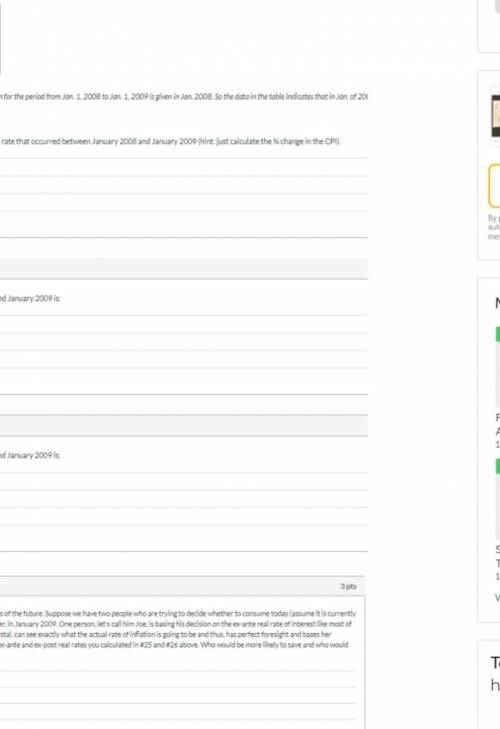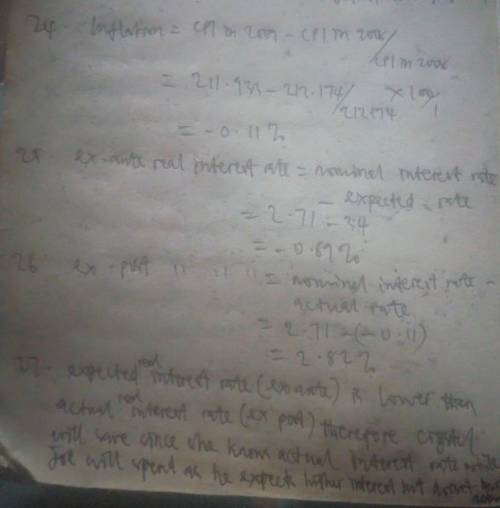
Business, 13.10.2020 04:01 reaperqueen21
We know that most decisions are in part, based on expectations of the future. Suppose we have two people who are trying to decide whether to consume today (assume it is currently January 2008) or save for the future and consume one year later, in January 2009. One person, let's call him Joe, is basing his decision on the ex-ante real rate of interest like most of us do. The other person who has a crystal ball, we'll call her Crystal, can see exactly what the actual rate of inflation is going to be and thus, has perfect foresight and bases her decision on the ex-post real rate. Look at the difference in the ex-ante and ex-post real rates you calculated in #25 and # 26 above. Who would be more likely to save and who would be more likely to spend? A. Both Joe and Crystal are savers. B. Both Joe and Crystal are spenders. C. Crystal saves, Joe spends. D. Crystal spends, Joe saves.

Answers: 2
Another question on Business

Business, 22.06.2019 08:00
Interest is credited to a fixed annuity no lower than the variable contract rate contract guaranteed rate current rate of inflation prime rate
Answers: 2

Business, 22.06.2019 12:30
howard, fine, & howard is an advertising agency. the firm uses an activity-based costing system to allocate overhead costs to its services. information about the firm's activity cost pool rates follows: stooge company was a client of howard, fine, & howard. recently, 7 administrative assistant hours, 3 new ad campaigns, and 8 meeting hours were incurred for the stooge company account. using the activity-based costing system, how much overhead cost would be allocated to the stooge company account?
Answers: 1

Business, 22.06.2019 21:50
Search engines generate revenue through pay-per-click (each time a user clicks a link to a retailer’s website); pay-per-call (each time a user clicks a link that takes the user to an online agent waiting for a call); or pay-per-conversion (each time a website visitor is converted to a customer)
Answers: 3

Business, 22.06.2019 22:20
With q7 assume the sweet company uses a plantwide predetermined overhead rate with machine-hours as the allocation base.and for q 10,11,13,and 14,assume that the company use department predetermined overhead rates with machine-hours as the allocation bade in both departements.7. assume that sweeten company used cost-plus pricing (and a markup percentage of 80% of total manufacturing cost) to establish selling prices for all of its jobs. what selling price would the company have established for jobs p and q? what are the selling prices for both jobs when stated on a per unit basis assuming 20 units were produced for job p and 30 units were produced for job q? (do not round intermediate calculations. round your final answers to nearest whole dollar.)total price for the job for job p -job q selling price per unit for job p q . how much manufacturing overhead was applied from the molding department to job p and how much was applied to job q? (do not round intermediate calculations.) job p job q manufacturing overhead applied for job p for job q . how much manufacturing overhead was applied from the fabrication department to job p and how much was applied to job q? (do not round intermediate calculations.)job p job q manufacturing overhead applied for job p for job q . if job q included 30 units, what was its unit product cost? (do not round intermediate calculations. round your final answer to nearest whole dollar.)14. assume that sweeten company used cost-plus pricing (and a markup percentage of 80% of total manufacturing cost) to establish selling prices for all of its jobs. what selling price would the company have established for jobs p and q? what are the selling prices for both jobs when stated on a per unit basis assuming 20 units were produced for job p and 30 units were produced for job q? (do not round intermediate calculations. round your final answer to nearest whole dollar.)total price for the job p for job q selling price per unit for job p for job q
Answers: 1
You know the right answer?
We know that most decisions are in part, based on expectations of the future. Suppose we have two pe...
Questions

History, 02.10.2019 00:00

Chemistry, 02.10.2019 00:00

Social Studies, 02.10.2019 00:00


History, 02.10.2019 00:00


Biology, 02.10.2019 00:00

Computers and Technology, 02.10.2019 00:00




Spanish, 02.10.2019 00:00

History, 02.10.2019 00:00

Mathematics, 02.10.2019 00:00



Social Studies, 02.10.2019 00:00


History, 02.10.2019 00:00






